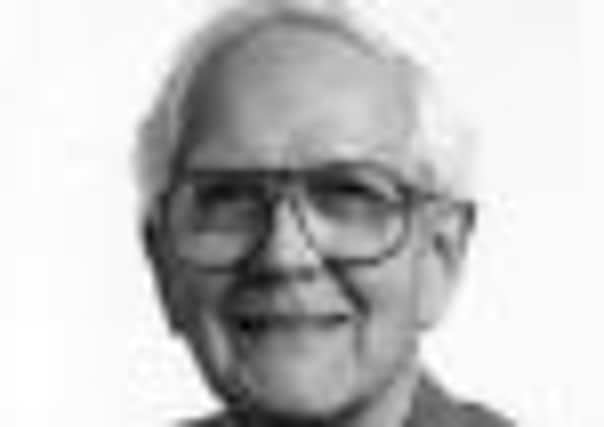Obituary: Dr Raymond Michael Gaze, neuroscientist


In one of those too frequently met ironies of our ageing population, the concluding years of Mike Gaze’s brilliant life contributing to the science of the brain were spent in Camilla House Nursing Home in the Grange, not knowing today from yesterday.
Gaze was born in 1927, in Essex, into a large family of one brother and seven sisters. The Second World War took the family to Moffat where, despite Gaze’s father holding strongly socialist views, schooling – other than a brief period at a preparatory school – was conducted at home by a succession of governesses and tutors.
Advertisement
Hide AdAdvertisement
Hide AdBy great good luck, one of them was DJ Salfeld who, having only just managed to escape from Nazi Germany, taught the elder Gaze children up to university entrance level in two years. In 1943, too young for usual entrance to university, Gaze passed the Edinburgh College of Surgeons entrance examination and, after some five years, began his medical career in Chelmsford and Essex Hospital.
Once again, however, Gaze’s father – who enjoyed describing himself as a peasant despite his successful business career – renewed his hoped for wish that Gaze should go to Oxford.
He did, matriculating in 1949 to read biochemistry under Sandy Ogston and did research for a PhD under George Gordon. The title of Gaze’s thesis was The Thalamic Response to Sensory Afferent Stimulation. Much of the actual experimental work was carried out in a sort of wire cage to protect the subject from extraneous electric stimuli. His thesis accepted, Gaze did two years’ National Service in the Royal Army Mediccal Corps at Tedworth Military Hospital on Salisbury Plain.
Free of this commitment which had hung over Gaze since he had turned 18, he was now able to accept an offer from Professor David Witteridge of a position and space for research in the Department of Physiology at Edinburgh University.
Witteridge was another key influence. He suggested following up studies by RW Sperry on the development of visual systems in frogs and fishes and the way severed nerve fibres grew back from the eye to the optic tectum, leading to various forms of functional recovery. This was potentially an immensely important field for research because anything to do with regeneration of nerve tissues helped to open the door to understanding the physiological and developmental mechanisms of repair to damaged nerve systems.
Sperry (1913-1994) was an American neuroscientist who won a Nobel Prize in medicine in 1981. Soon publication of Gaze’s research at Oxford attracted PhD students to Edinburgh from distant universities, financial support being provided by the Science Research Council.
One of the first to join Gaze’s group was Marcus Jacobson, later to become a professor in the Department of Neurobiology and Anatomy at the University of Utah. Many were to follow and the growth and later senior positions held by Gaze’s teams became a reflection of the importance of his leadership.
After ten years in Edinburgh, in 1970 Sir Peter Medawar (1915-1987) invited Gaze to set up a new Division of Developmental Biology at the National Institute of Medical research at Mill Hill in London, where he was joined by some of his team from Edinburgh and a dozen or so other scientists, including RA Hope, subsequently Professor of Medical Ethics at Oxford.
Advertisement
Hide AdAdvertisement
Hide AdAlthough Gaze had been married since 1957 to Robinetta Armfelt, had three children and a happy welcoming home in Highgate, returning to Scotland remained a strong pull. The upshot was that in 1984 the Medical Research Council accepted a proposal to move the Neural Development and Regeneration Group to Edinburgh where the Professor of Zoology Murdoch Mitchison offered space in his department, where the unit remained until Gaze’s retirement in 1992.
Aubrey Manning, who followed Mitchison in the Chair of Natural History, recalls that “Mike Gaze and members of his research group were regulars at departmental seminars where Gaze’s ability in discussion to move to the very centre of any argument was much valued. He was a firm but meticulously kind teacher. Every year he would offer short projects on the neural development of amphibians for zoology honours students to work on as a major part of their final year work. Students who chose these projects were indeed fortunate.
“They were welcomed into Gaze’s team and became trained to a high standard in both the method and ethos of research. For several students this experience stayed with them through their subsequent careers.”
Between 1952 and 1993, Gaze authored or co-authored 104 scientific papers. At Oxford in 1956, he won the Rolleston Memorial Prize; from 1962-1966 was the Alan Johnston, Lawrence and Moseley research Fellow of the Royal Society; he was made a Fellow of the Royal Society of Edinburgh in 1964; and elected a Fellow of the Royal Society in 1972.
Amongst his many positions Gaze was also Visiting Professor of Biology, Middlesex Hospital Medical School 1971-4 and Visiting Professor of Theoretical Biology at the University of Chicago in 1972.
Despite the time-consuming nature of his career devoted to medical research, Gaze managed to pack in many other activities – playing the flute in departmental concerts, delving deeply into Roman antiquities, hill-walking and a special interest in the concept of private ownership.
Perhaps this stemmed from his strongly socialist father and he amassed a considerable body of information on the subject which, alas, degenerated into a muddle of computer files as his mind emptied of its former brilliance.
He was a close friend from when we first met at Holywell Manor in 1949, at that time an undergraduate annex to Balliol, and remained so for the next 60 years, supported throughout a long marriage by his wife Robinetta, who survives him with their three children and five grandchildren.
THOMAS HUXLEY